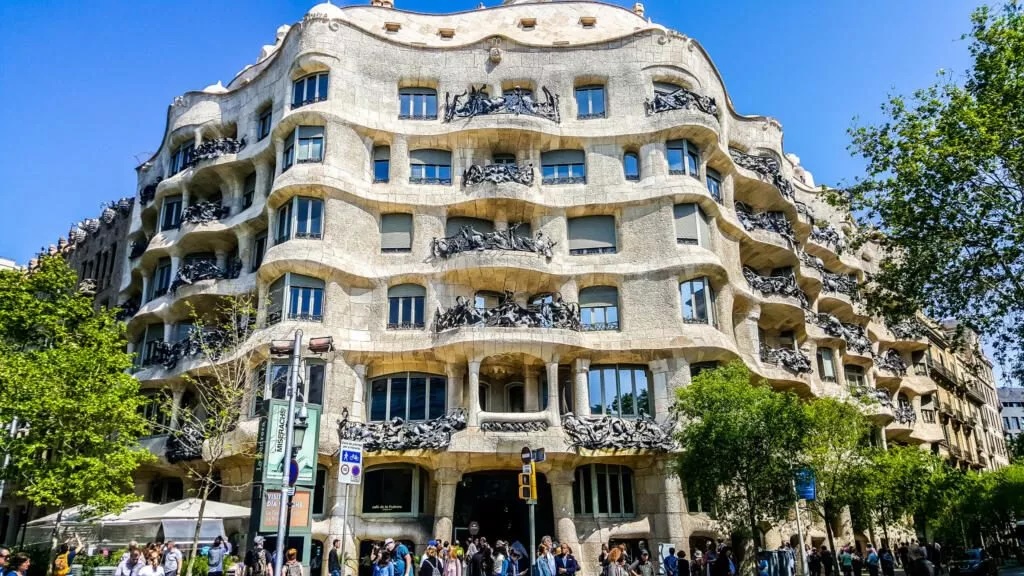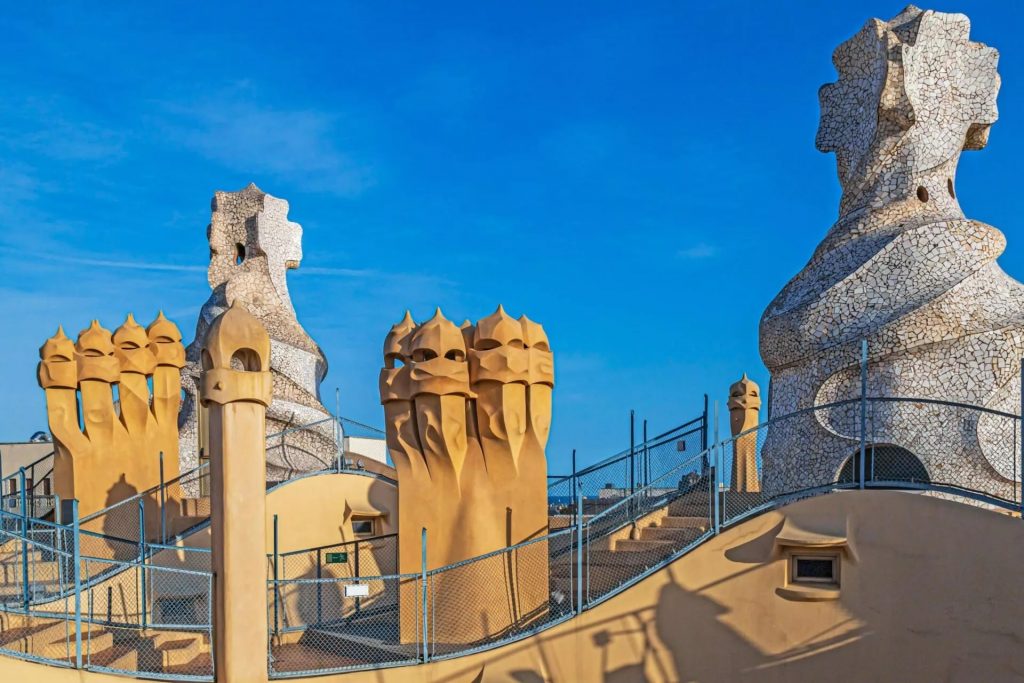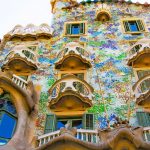Casa Milà, also known as La Pedrera, is a place I had always seen on postcards and in travel guides, but it wasn’t until I stood before it in person that I understood why it is so extraordinary. From the very first glance, I was captivated by the wavy lines of the facade and the original balconies, which make the building look like a living, breathing structure.
By purchasing tickets through my links, you save time, money, avoid queues, and help support the growth of my blog. Thank you in advance!
As I entered, I felt like I was stepping into another world – full of natural forms and breathtaking details. This is not an ordinary building; it’s a true masterpiece that you have to see in person to fully understand its magic. After just a few minutes, I knew that this visit would stay with me for a long time. Gaudí’s architecture truly has the power to surprise and leave a lasting impression.

Every step through La Pedrera felt like uncovering another mystery. And I knew right then that I had to share this experience with you!
A brief history of Casa Milà – Gaudí’s masterpiece
Casa Milà was designed by Antoni Gaudí at the request of wealthy industrialist Pere Milà and his wife, Roser Segimon. Construction began in 1906 and lasted until 1912, and the final result sparked a lot of emotions. At that time, the Modernist style, which Gaudí boldly embraced, was not yet fully understood by the people of Barcelona. La Pedrera, with its unusual facade and lack of traditional straight lines, was controversial and even criticized by many.
As always, Gaudí drew inspiration from nature – the undulating shapes of the facade were meant to mimic the movement of ocean waves, and the balcony railings resemble seaweed and other marine plants. The project was also groundbreaking from a technological perspective. Casa Milà was one of the first buildings to have an underground parking garage for cars, a revolutionary idea in the early 20th century!
Despite the initial criticism, over time Casa Milà came to be regarded as one of Gaudí’s most important works. In 1984, it was inscribed on the UNESCO World Heritage List, further confirming its significance in architectural history. Today, it’s hard to imagine Barcelona without this extraordinary building, which stands as one of the city’s landmarks and a testament to Gaudí’s genius in creating something truly unique.
By purchasing tickets through my links, you save time, money, avoid queues, and help support the growth of my blog. Thank you in advance!
Unique architecture: What makes La Pedrera so special?
When I first stood in front of Casa Milà, I understood why it’s called La Pedrera – it looks like a sculpture carved from stone, full of life and movement. This is not an ordinary building, but a true work of art. At first glance, it’s clear that Gaudí drew inspiration from nature. The facade undulates like the sea, and the balconies, adorned with iron railings, remind me of delicate marine plants.

What surprised me the most was the absence of straight lines – here, everything flows, every element seems to have its own life. Even the windows are not ordinary – each one looks as if it were cut by the hand of an artist. Walking through the courtyard, I felt as though I was in a fairy-tale world. The light streaming through the glass domes scattered across the colorful walls, creating an atmosphere of calm and mystery.
However, the biggest impression on me was the roof. When I reached the top, I was literally speechless. Those extraordinary chimneys – each one different, each sculpted into organic forms – look like guardians, watching over this magical place. Gaudí paid attention to every detail, creating something that is both functional and artistic. The roof of La Pedrera is something you can’t miss – the view of Barcelona from here is simply incredible.
La Pedrera is more than just a building. It’s a journey into the world of imagination, where architecture meets nature in the most surprising way. Anyone who comes here with open eyes will leave enchanted – just like I did!
Tips for visitors: How to best plan your visit?
If you’re planning to visit Casa Milà, I have a few practical tips that can make your experience even better. First, I recommend purchasing tickets online in advance – this way, you’ll avoid the long queues that often form, especially during the tourist season. I personally bought my ticket online and saved a lot of time.
By purchasing tickets through my links, you save time, money, avoid queues, and help support the growth of my blog. Thank you in advance!
The best time to visit is in the morning, right after opening, or in the late afternoon, when most tourists have already left the building. This way, you can wander through the interiors freely without rushing through crowds. If you have the chance, definitely opt for a night visit – the view of Barcelona illuminated from the roof of La Pedrera is something that will stay with you forever.
Another important tip: bring comfortable shoes! While La Pedrera isn’t enormous, it’s a building full of stairs, nooks, and winding paths, so be prepared for a lot of walking. It’s also a great idea to bring a camera, as every step offers something you’ll want to capture – from the fairy-tale details of the interior to the stunning views from the roof.

Finally, remember to plan a bit more time than you think you’ll need. Casa Milà is a place that captivates with every detail, and once you’re there, you won’t want to rush. I ended up spending far more time than I originally planned, but I don’t regret a single minute!
Casa Milà at night: A rooftop show worth seeing
If you think La Pedrera is stunning during the day, just wait until you see it at night. I had the chance to attend the evening event on the roof, called La Pedrera Night Experience, and I must say it was one of the most magical experiences I’ve had in Barcelona.
After dark, the roof of Casa Milà becomes the backdrop for an incredible light and sound show that transports you to a completely different world. The chimneys, which during the day look like sculptures from another planet, take on an even more surreal character at night thanks to the play of light, shadows, and colors. The show is perfectly synchronized with music, making the entire performance feel meditative, yet deeply emotional.
The view from the rooftop at night is equally spectacular – the city illuminated by thousands of lights creates a breathtaking sight. I stood there in awe, admiring the panoramic view of Barcelona, while also feeling how Gaudí’s architecture lives and breathes in this unique lighting. It’s worth setting aside time for this show, as the nighttime atmosphere at La Pedrera is truly unforgettable.
By purchasing tickets through my links, you save time, money, avoid queues, and help support the growth of my blog. Thank you in advance!
Night tours also offer the chance to see La Pedrera from a completely different perspective, free from the daytime tourist bustle. I felt as though I was part of something special, as if Gaudí himself intended for his masterpiece to be discovered in the light of the moon. It’s definitely worth experiencing this place in such a unique way.
Fascinating facts about Casa Milà that few know
During my visit to Casa Milà, I uncovered some fascinating facts that few people have heard of, which further enrich the experience of this extraordinary building. The first surprising fact is that in the early 20th century, when the building was completed, not all Barcelona residents were thrilled with its appearance. Some even called it “the quarry,” or “La Pedrera.” Today, looking at its undulating facade, it’s hard to believe it was once so criticized!
Interestingly, Casa Milà was also a pioneer in modern conveniences. Gaudí designed the building to be one of the first in Barcelona with an underground parking garage, which at the time was a revolutionary idea. It’s clear that Gaudí was ahead of his time, not only in terms of artistry but also practicality.
Another little-known fact is that Gaudí initially planned to place a large sculpture of the Virgin Mary atop the facade. Unfortunately, these plans were rejected by city authorities, who felt the building was already controversial enough. Gaudí often emphasized his religious inspirations, so this element was meant to be a tribute to his deep faith.
It’s also worth noting that La Pedrera was one of the first buildings designed with natural lighting and ventilation in mind. Thanks to openings in the central courtyard and the use of different windows, the interior is always filled with natural light, and air circulates freely, making the building incredibly comfortable.
Finally, something that particularly fascinated me – the roof of La Pedrera, with its famous chimneys, is not only a work of art but also a functional architectural element. The chimneys are designed to optimally vent smoke, and their unique shapes serve both aesthetic and practical purposes.
These and many other facts make La Pedrera more than just a beautiful building – it’s a place full of secrets and innovative solutions that reveal something new with every step.
Conclusion: Why Casa Milà is a must-see
Casa Milà, also known as La Pedrera, is undoubtedly one of the places you must visit when in Barcelona. It’s not just about it being a Gaudí masterpiece that has become a symbol of modernist architecture. It’s a place that transports you to a different dimension, full of organic shapes, incredible details, and architectural solutions that still impress today.
Visiting La Pedrera, you not only admire the facade that looks like a wave sculpted in stone, but you also discover interiors filled with light, colors, and unique symbolism. Walking on the terrace, I felt like I was in a magical place where nature meets architecture, and every element has a hidden meaning.
If you’re looking for a place in Barcelona that truly takes your breath away, La Pedrera is the perfect choice. Both by day and night, this building has a life of its own and allows you to experience how extraordinary architecture can be. For me, it was a journey full of awe and inspiration that I recommend to anyone who wants to see Gaudí’s genius firsthand.
Don’t forget that Casa Milà is also a place full of history and intriguing facts, making it even more special. It’s more than just a landmark – it’s an experience that stays in your memory for a long time. Don’t miss the opportunity if you’re planning a visit to Barcelona!
By purchasing tickets through my links, you save time, money, avoid queues, and help support the growth of my blog. Thank you in advance!





